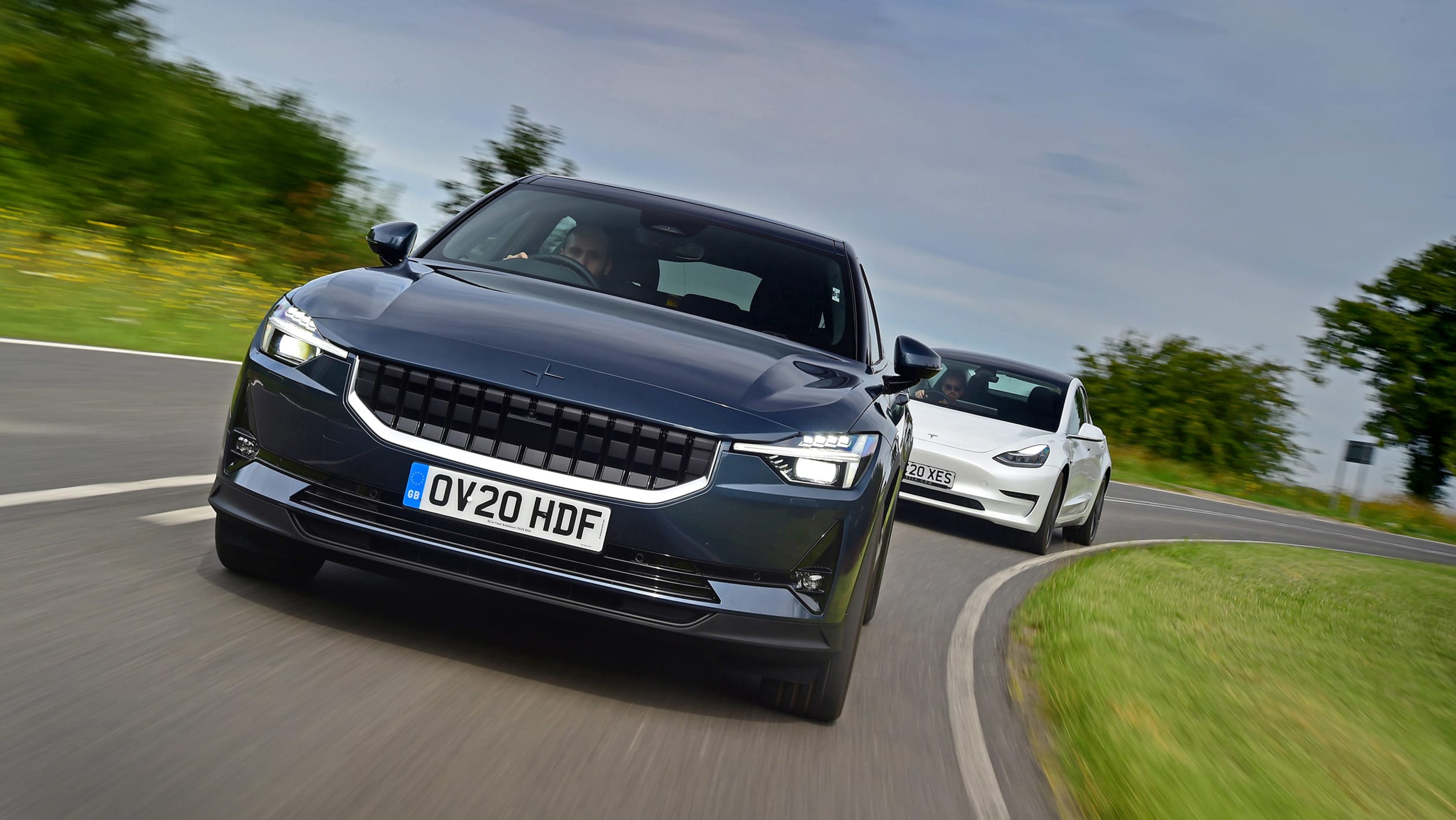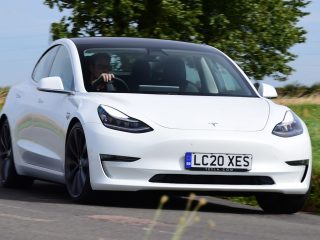Can Polstar’s incoming Polestar 2 take on Tesla’s popular Model 3? We find out ahead of the model’s Australian debut.
As you might have guessed, the Polestar 2 is the emerging premium Swedish brand’s second offering. However, it’s also Polestar’s first fully electric car, because the flagship 1 model was fitted with a plug-in hybrid powertrain.
It’s a compact fastback (looks like a sedan, is actually a hatchback) family car that, in Performance Pack guise, is priced (in Europe for now) close to the Tesla Model 3.
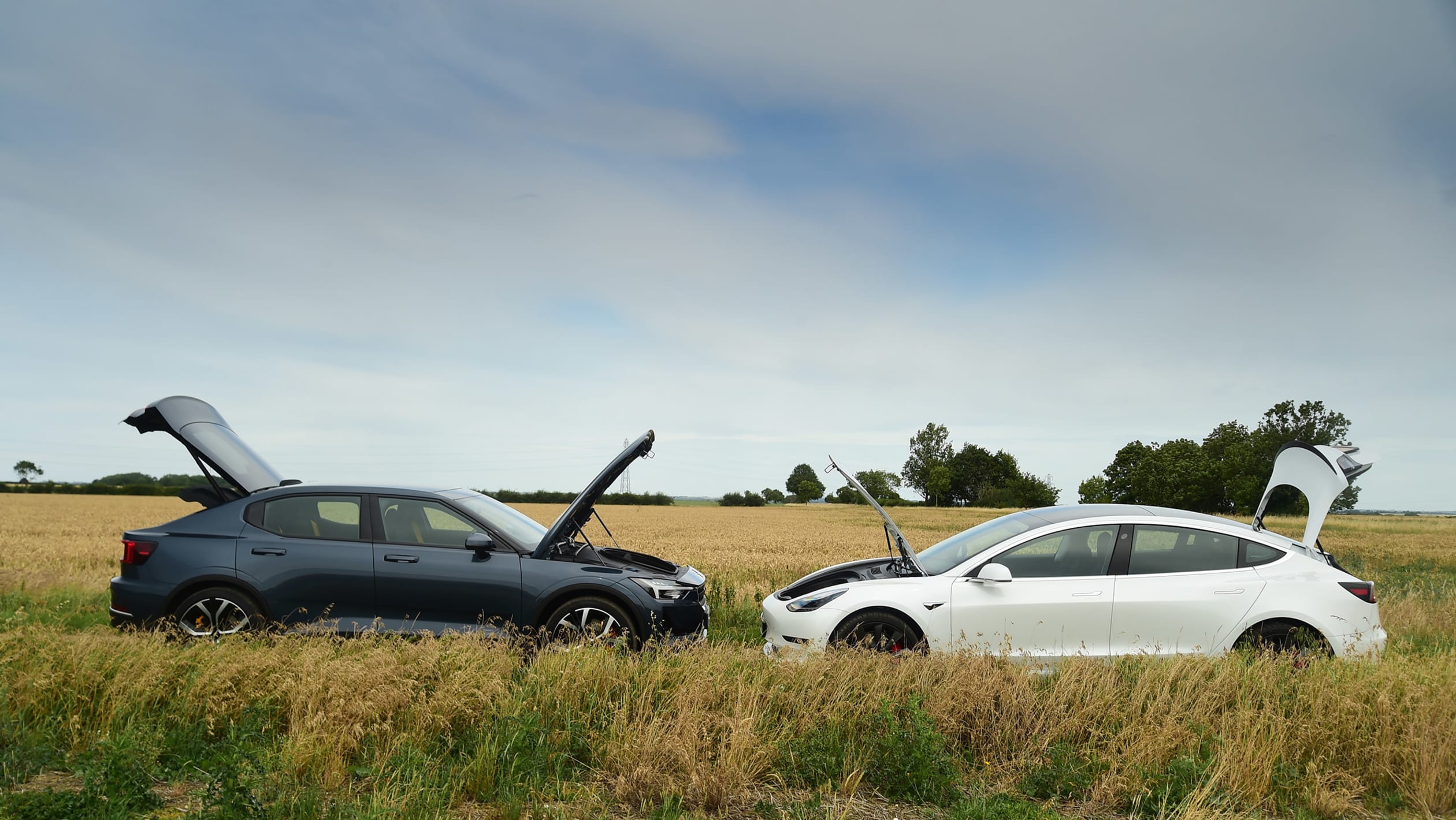
In Australia, the Tesla Model 3 is priced from $73,900 before on-roads in base model trim, and $95,000 in this tested Performance variant. Polestar is yet to announce pricing for its first model here which is slated to arrive late-2020 or early 2021.
Few brands have risen from obscurity to dominance like Tesla. The American firm has gone from making modified Lotus Elises, installing its batteries and electric motors in place of a petrol engine, to designing and building some of the most advanced EVs in existence in a matter of years.
It’s now the premium electric car brand to benchmark against, which is why we’ve pitched Polestar against Tesla here.
Both offer the performance and image you’d expect from a premium EV, but also the kind of statement infotainment system and connected car technology the best and most modern machines in the class need to offer, so the battle will be fought on many fronts.
Polestar 2
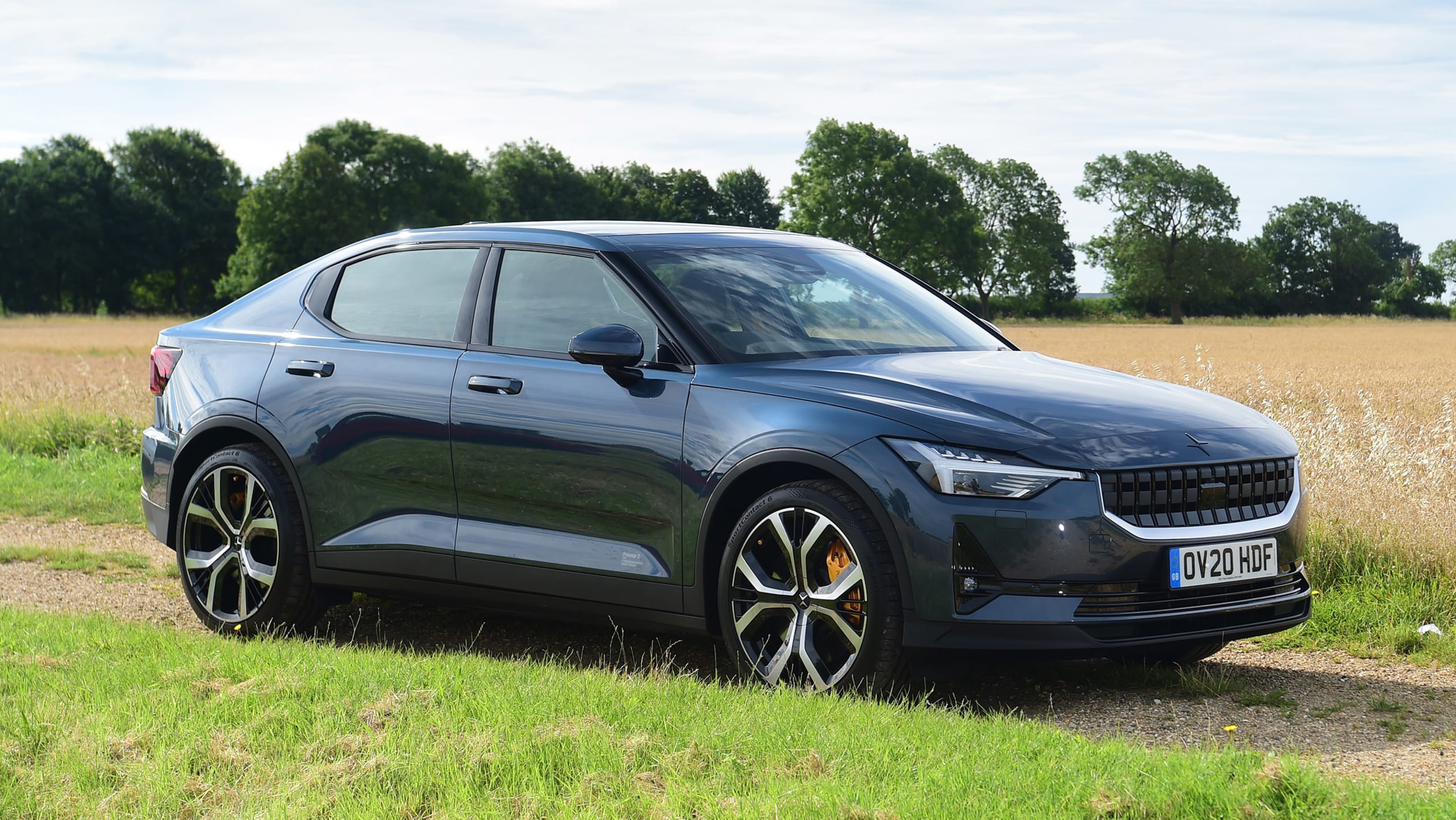
| Model: | Polestar 2 Performance Pack |
| Price: | $95,000 (Overseas, Australia TBA) |
| Powertain: | Dual electric motors/lithium-ion battery, 402bhp |
| 0-60mph: | 4.7 seconds |
| Test economy: | 5.1km/kWh |
| CO2: | 0g/km |
The all-new Polestar 2 electric car is a statement of intent, going up against the Tesla Model 3. We do not have pricing for Australia yet, though the top Performance Pack tested here is priced £51,900 or $95,000 in local dollars. But does the Polestar measure up elsewhere, too?
Design & engineering
Unlike many electric-only cars – and the Tesla here – the Polestar 2 is underpinned by a platform that also accepts combustion engines. It’s called CMA (Compact Modular Architecture) and is shared with Volvo.
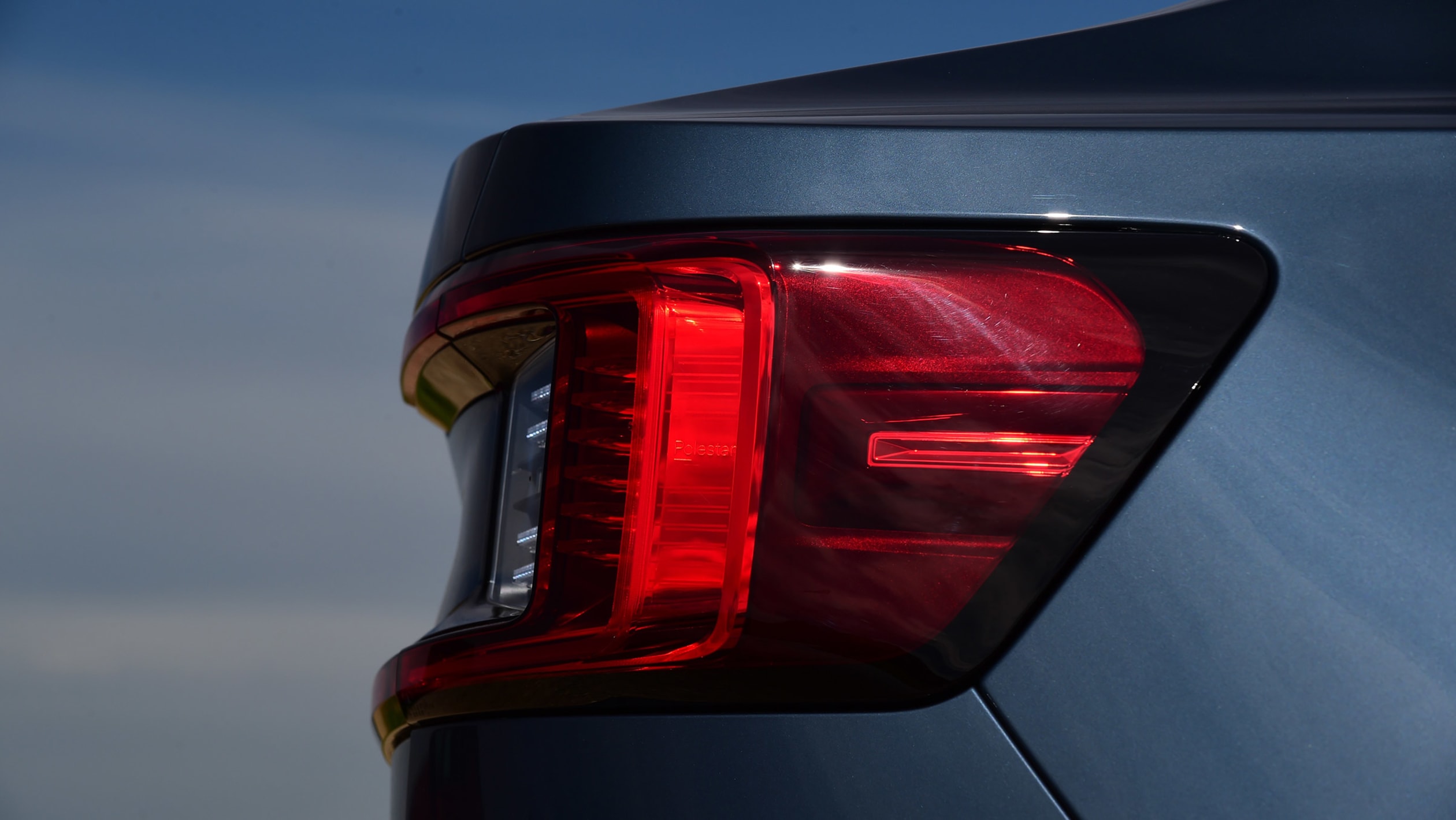
The Polestar’s 78kWh lithium-ion battery is located in the floor and down the car’s spine in what would be a petrol or diesel model’s transmission tunnel. The battery sends its energy to electric motors on the front and rear axles, giving four-wheel drive and a total of 300kW and 660Nm of torque.
Polestar also claims 470km from a full charge, which is a respectable figure, but as much as the brand’s clever electronic engineering gives the 2 its ability, our Performance Pack-equipped model also features some lovely mechanical engineering. This includes Ohlins Dual Flow Valve manually adjustable suspension dampers that offer 22 clicks of range to fine tune the suspension settings. Four-piston Brembo brakes and 20-inch forged alloy wheels also feature.
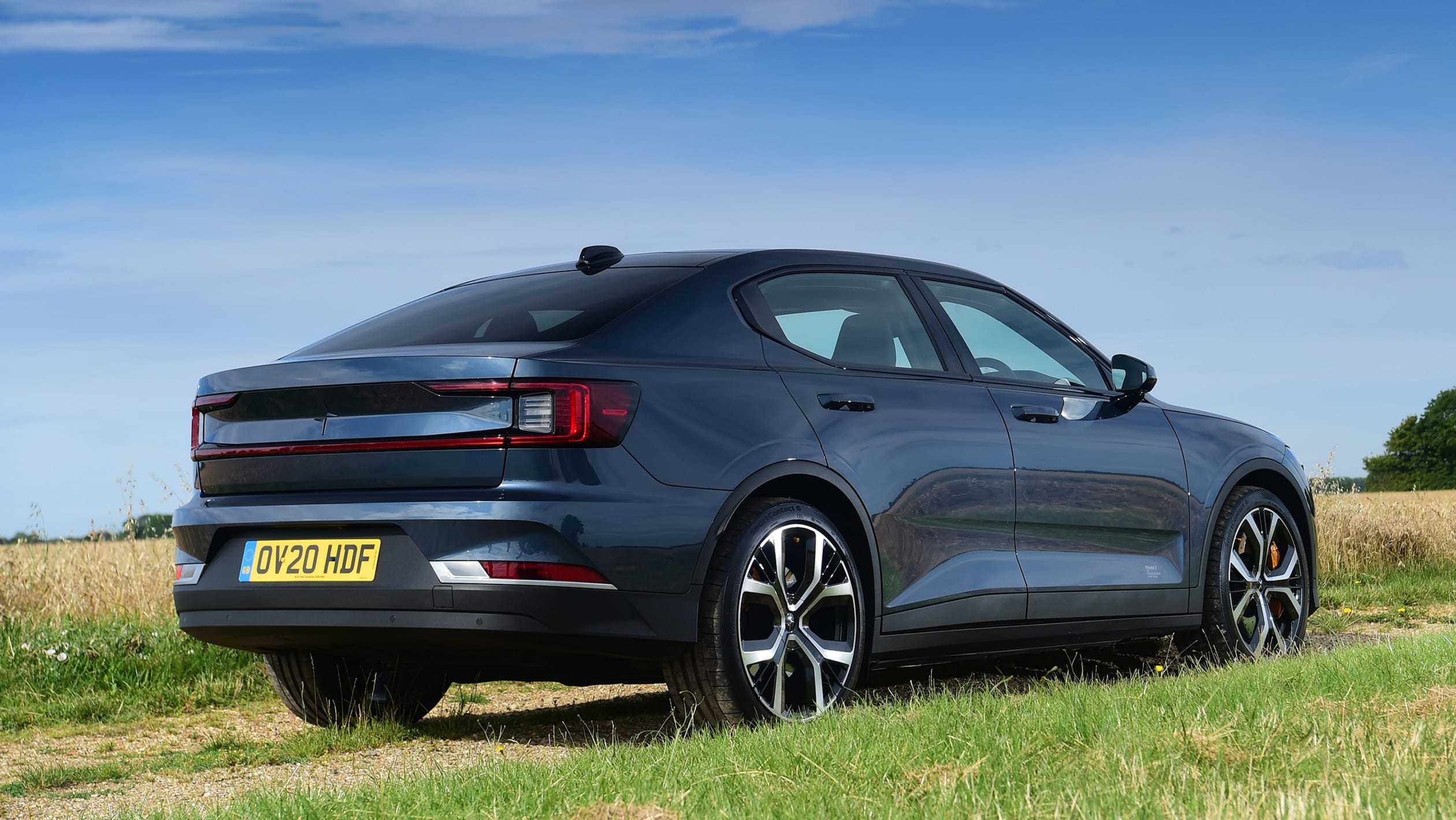
The Polestar 2 neatly blends this mechanical and electrical focus, because inside there’s tech to match the Tesla. Its multimedia is powered by Android and it’s nicely integrated into the high-quality cabin. It edges the Tesla for build and finish.
Driving
You can tell that the Polestar has been engineered by a group that has a legacy in the car world. The 2 steers more sweetly than the Model 3. The speed of the steering is also better suited to the chassis, and while there isn’t really any feedback, the way the car turns and the messages you get back from it feel clearer than in the Tesla.
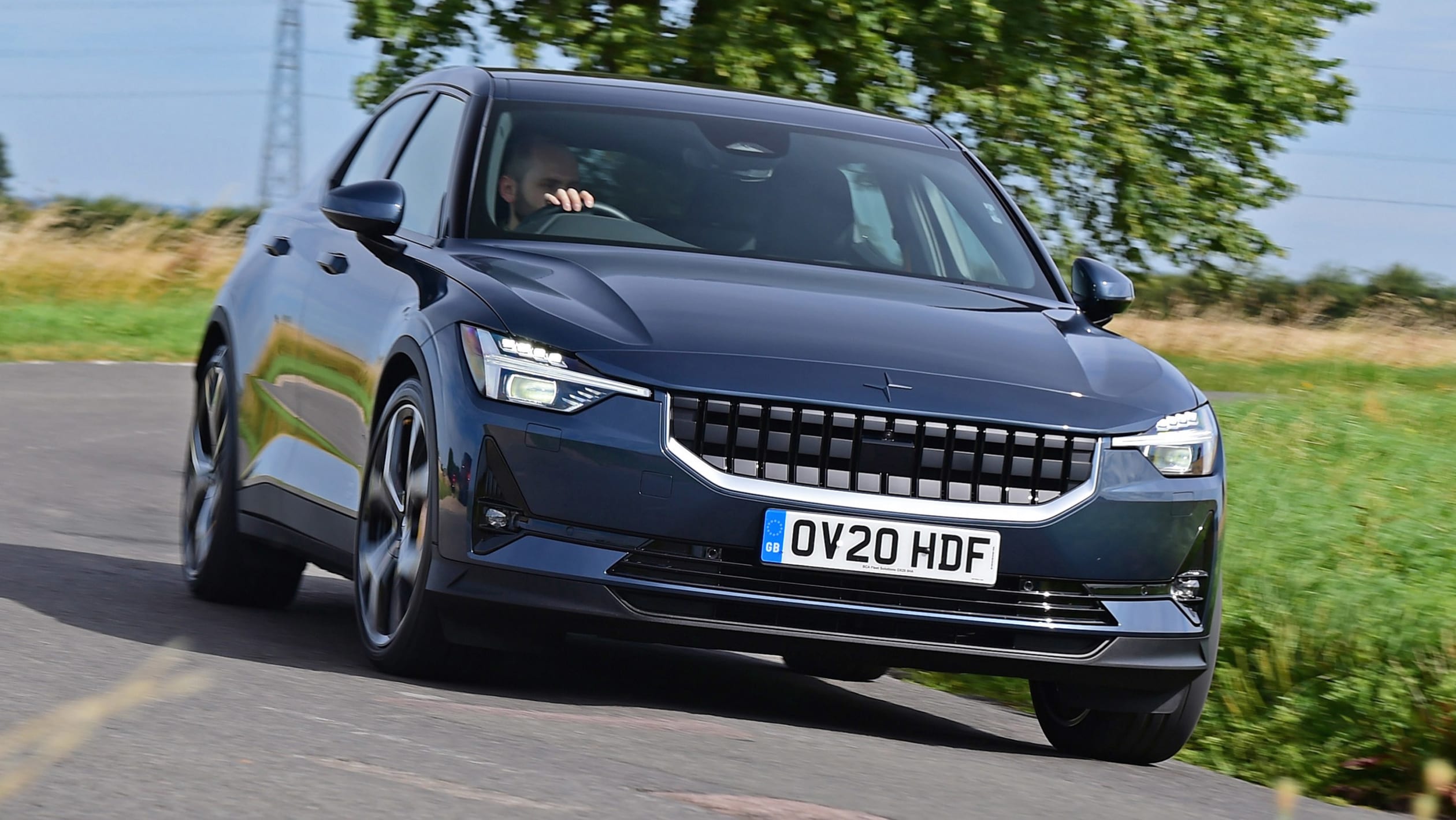
There’s a good level of grip and the Polestar feels better balanced between its front and rear axles when it comes to their bite. It’s undoubtedly helped by the sophisticated Ohlins dampers, but while they make the Polestar a surprisingly fun and tidy-handling car given its weight, they seem like an odd choice for a family EV. That’s because the manual adjusters for the dampers aren’t easily accessible; we’re not sure owners will be crawling under their cars or jacking them up to tweak the settings.
They might want to, though, because the dampers in their standard setting mean the ride is on the firm side. But you can immediately tell the quality of the damping, because the Polestar isn’t crashy or harsh, and the body’s chunky mass is controlled resolutely.
It does mean the 2 is just a little less comfortable than the Model 3 around town and on the motorway, where these cars will likely spend a lot of time. It’s not unbearable, though – just firm.
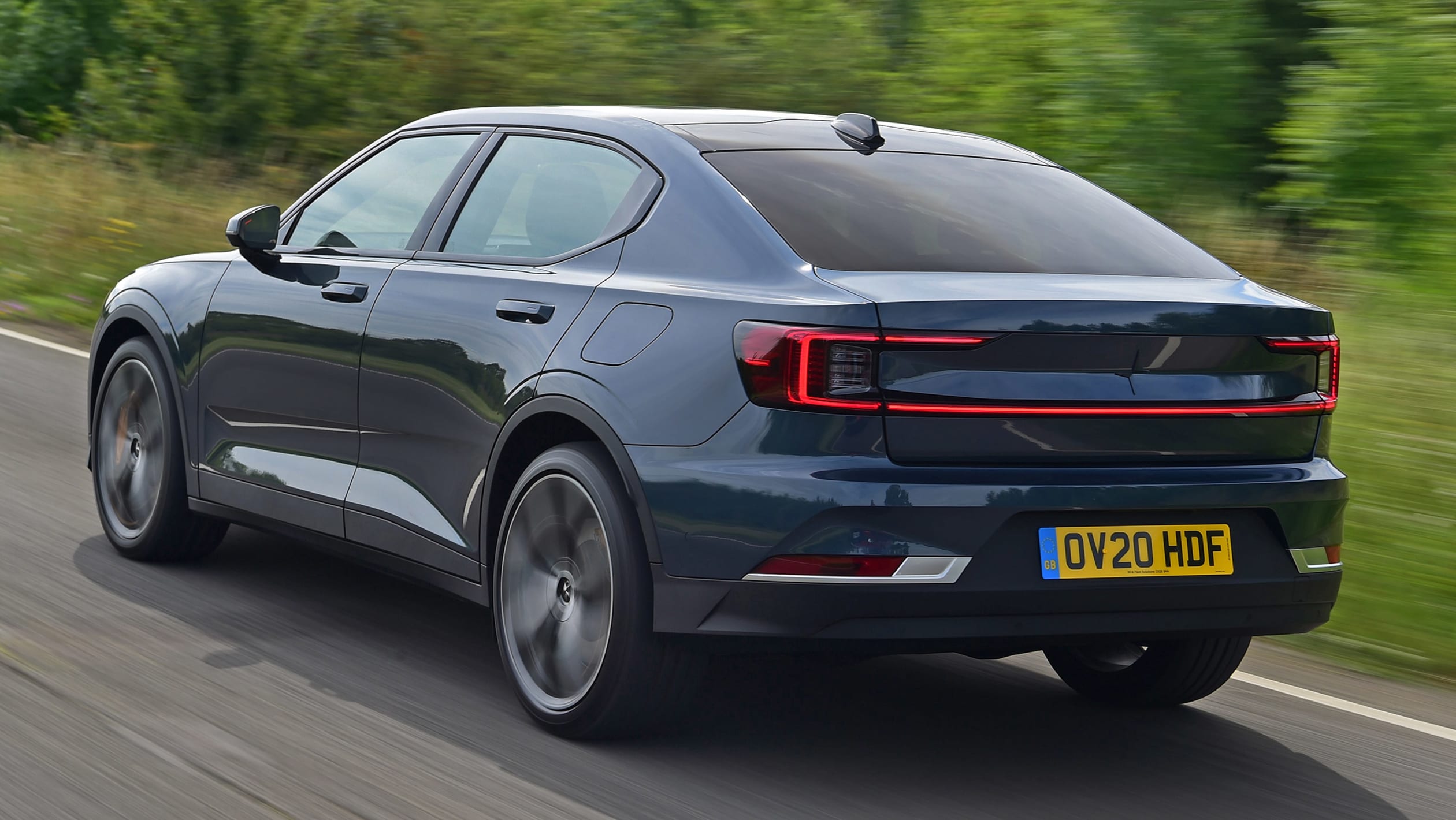
The 2 also can’t match the Tesla’s performance, but then not many competitors can, and this level of power and torque still gives the Polestar sports car speed. The 0-100km/h sprint takes 4.7 seconds, which is more than quick enough, but it’s the any-speed hit of torque as you squeeze the throttle to the floor that defines both of these electric cars.
Practicality
The Polestar offers respectable range, even if it’s down on the Tesla, but charging is also key to practicality. The 2 accepts up to 150kW DC rapid charging – here the Polestar only takes 27 minutes for an 80 per cent top up. A 50kW feed pushes this to just over an hour.
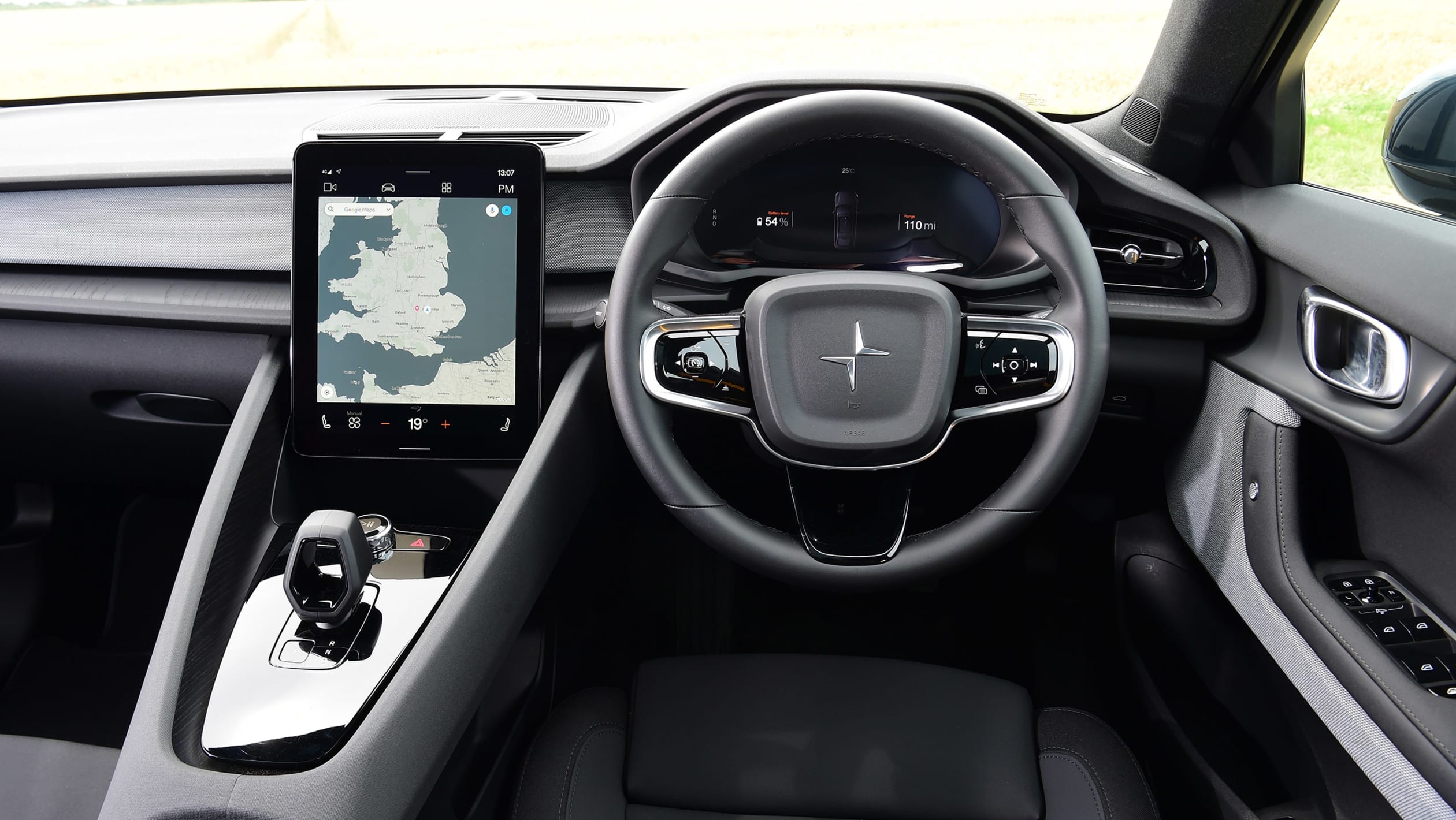
Given the range on offer, owners might not need to use public charging too much, preferring to top-up overnight at home instead. Using the 11kW on-board charger with an AC wallbox supply at this level, the battery will go from empty to full in seven hours and 45 minutes. It’s very closely matched to the Tesla here, but while the Model 3 is a sedan, the 2 is a hatchback, so it’s easier to load larger items. There is 405 litres of boot room in the rear, plus an extra 35 litre space in the front, which is enough room for the charging cables, but it’s not quite as large as the Tesla’s ‘frunk’.

Space in the rear seats is fine, but the flat roofline isn’t quite as accommodating as the Tesla’s swoopier roof. Both have panoramic glass panels, but in the Polestar it eats into headroom. Legroom is okay, but not quite as generous as in the Model 3.
Ownership
Polestar is an emerging brand, so it didn’t feature in Automotive Daily’s partner Driver Power poll, but it uses much of the same tech as sister brand Volvo, which took 10th place out of 30 brands.
Some of that Volvo tech extends to safety, which is excellent. The Polestar has lane-keep and blind-spot assist, AEB, semi-autonomous cruise control, cross-traffic alert, rear collision warning and collisions avoidance as standard.
Running costs
If you’re buying an EV, running costs have got to be part of the appeal, and both cars are impressively cost-effective. The 2’s 78kWh battery offers 72.5kWh of usable energy, so based on a home electricity cost of 35c per kWh, a full charge will cost $25.37. The Tesla’s 75kWh-rated battery offers exactly the same amount of usable energy, so recharge costs are the same.
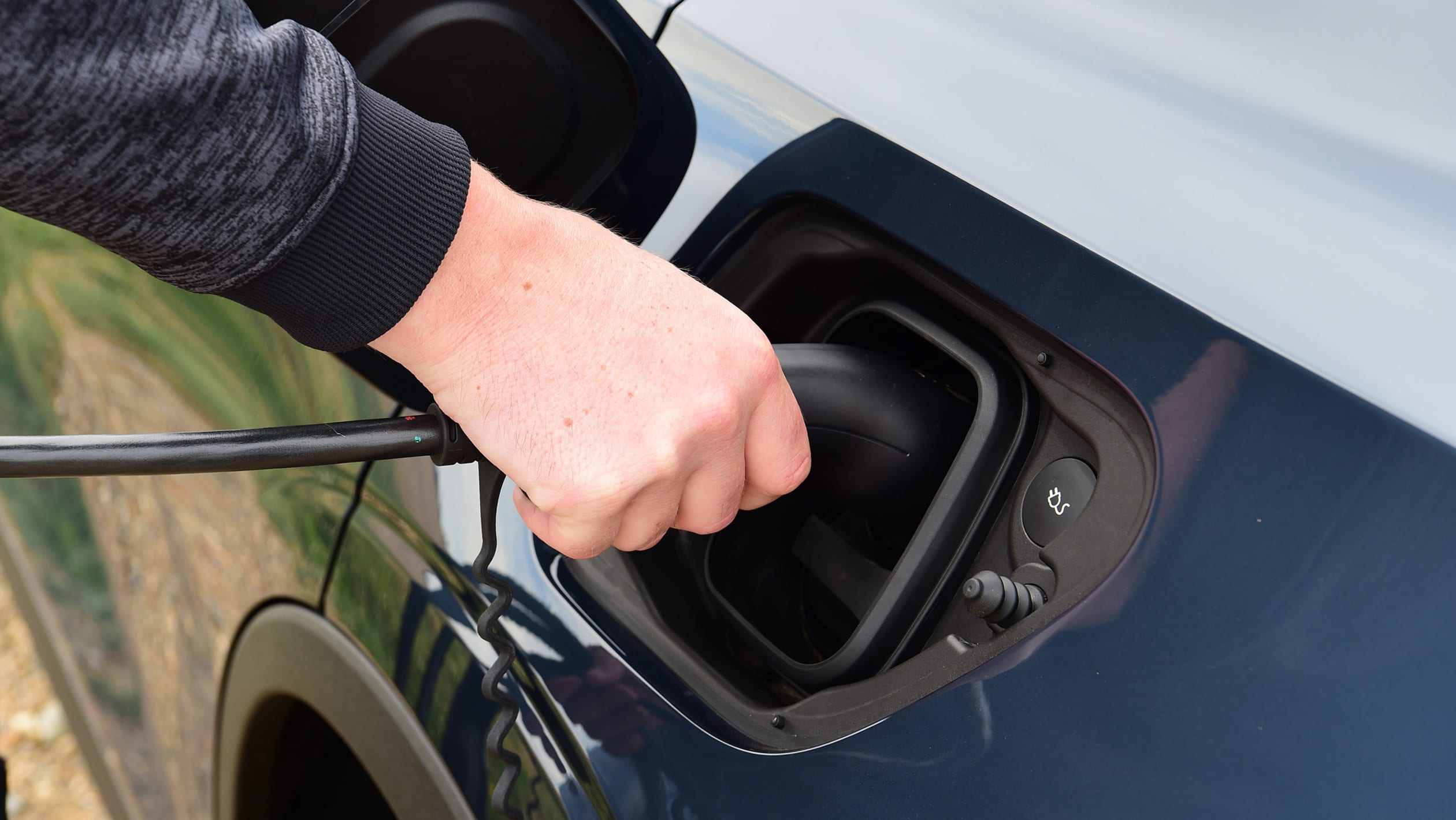
The Polestar achieved efficiency of 5.1km per kWh, which means a predicted range of 373km, so an average 20,000km per year will cost you $1360 in energy. This compares with $1208 for the Model 3, which returned stronger efficiency of 5.8km per kWh (for a real-world range of 420km). However, both models will be incredibly cheap to run given the performance they offer.
Testers’ notes: “You don’t get leather on the Polestar. That’s because the 2 has a vegan interior, so there are no animal products present. It’s very 2020, but the mix of materials and textures works nicely and feels cool.”
Tesla Model 3
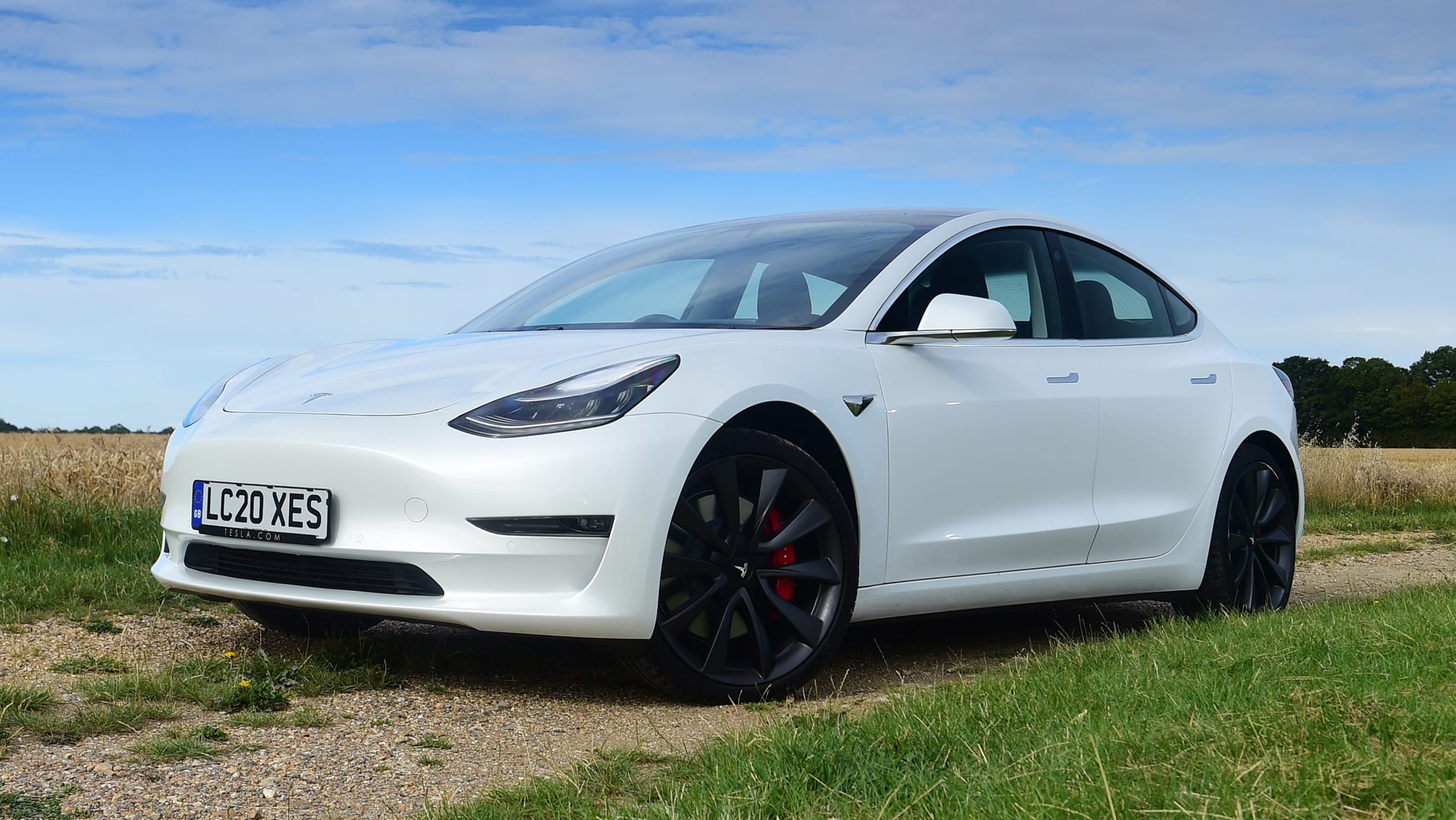
| Model: | Tesla Model 3 Performance |
| Price: | $95,900 |
| Powertain: | Dual electric motors/lithium-ion battery, 483bhp |
| 0-60mph: | 3.2 seconds |
| Test economy: | 10.6km/kWh |
| CO2: | 0g/km |
In Dual Motor Performance trim, the Tesla Model 3 is only just a bit more expensive than the Polestar 2 Performance pack, but it offers more performance and range. Is it worth the extra?
Design & engineering
The Model 3 uses Tesla’s tried-and- tested skateboard architecture that it pioneered for electric cars – it’s rapidly become the norm for many manufacturers. It uses a chassis with the battery sandwiched in the floor and, on this Model 3 Performance, a motor on each axle.
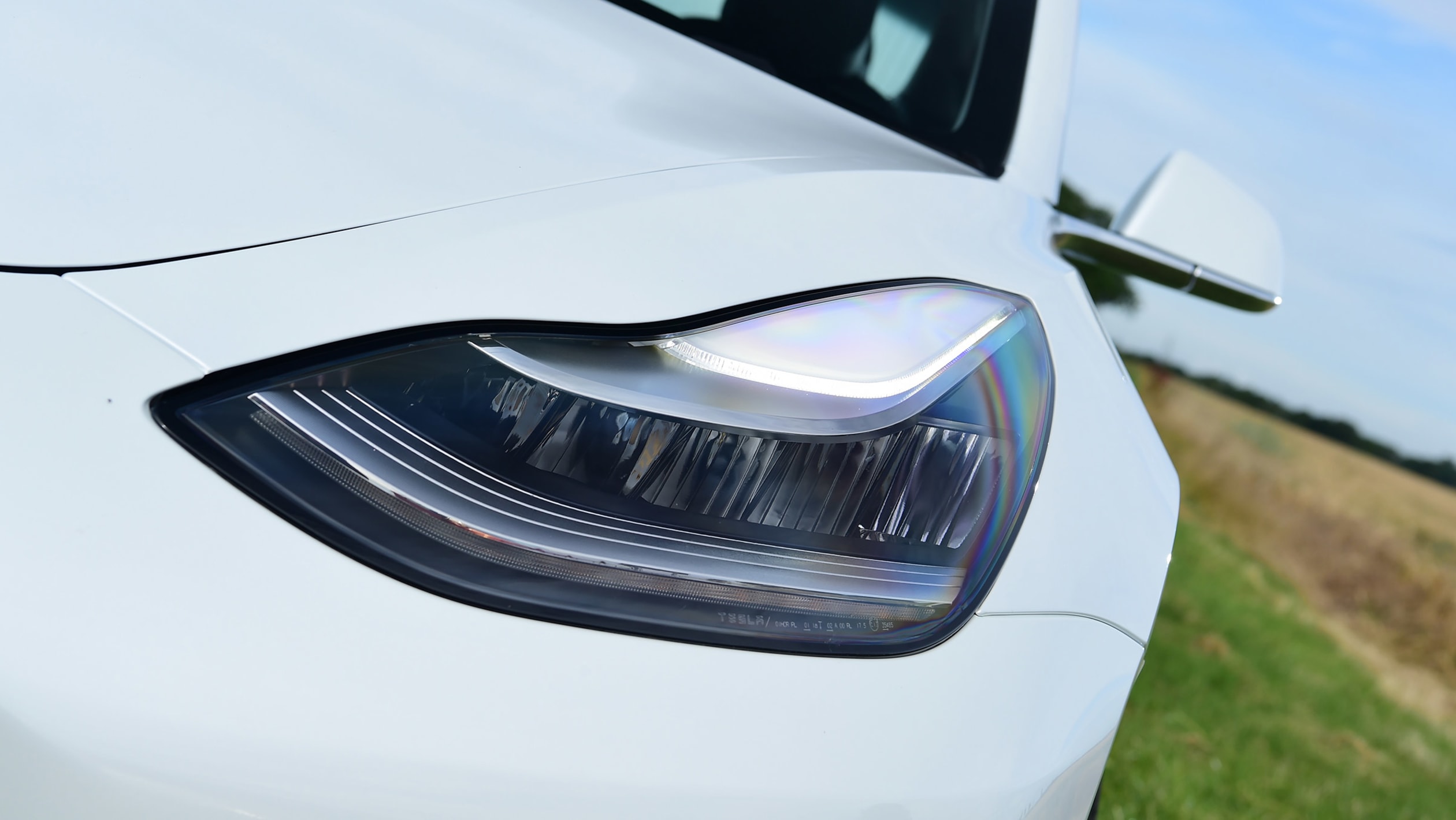
The 75kWh battery is slightly smaller than the Polestar’s, but it offers the same 72.5kWh of usable energy. Given the Tesla weighs only 1847kg compared with the 2198kg Polestar, this means a claimed range of 529km. That’s 59km more.
Those motors combined push out 360kW and 660Nm of torque. This first figure is more than the Polestar; the second matches it. Like the 2 with the Performance pack, the Model 3 Performance features 20-inch alloys, upgraded brakes and some suspension tweaks (it’s lowered, but the dampers are adaptive).
Those are the mechanical tweaks, but as you’d expect with advanced electric cars like these, a lot is also controlled by software. The engineering here includes torque vectoring by braking and plenty of electronic adjustment for the steering weight, regenerative braking level and accelerator pedal response. The Polestar 2 offers this functionality, too.

While the Tesla may offer more claimed range, plus more power and torque, it can’t match the Polestar for quality and finish. The build of Teslas has improved over the years to the point where the Model 3 is the best of the breed, but it can’t compete here on this front. The materials are okay – the dash top and wood trim give a clean look – but then the plastic covers for the central storage area are cheap and feel flimsy.
Driving
Even the most hardened EV sceptics will be convinced the first time they use full throttle in the Model 3 Performance. It is incredibly quick. Tesla claims 0-100km/h takes just 3.2 seconds, and the punch off the line is superb. It feels noticeably faster and more alert on the throttle than the Polestar, not that the 2 feels slow, while its mid-speed acceleration is stronger.
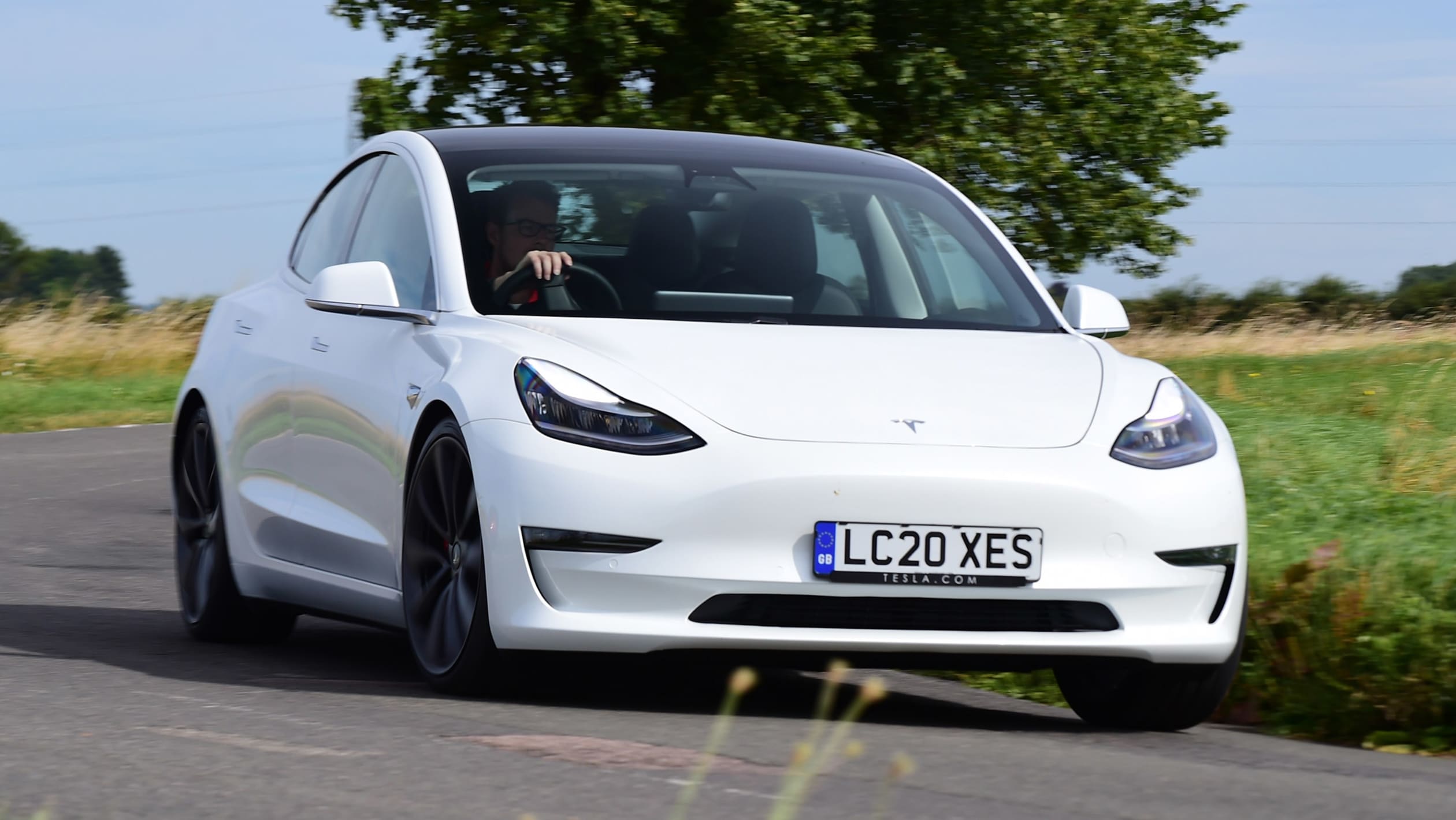
Few combustion-engined cars can match the Model 3 for pace on the road because it’s so easily accessible, with no discernible lag. Even at motorway speeds the Tesla streaks forward when you ask for it. Yet the characteristics of the drivetrain that make it so fast don’t compromise it around town. The throttle is less aggressive at the top of its travel than the Polestar’s, so it’s smoother at low speed, while it’s pretty much just as refined.
You hear a little more noise from the suspension, but the softer set-up means the Tesla’s body and wheels take rolling undulations and some bumps more gently. The 20-inch wheels do still bounce over big marks on the road surface, though.
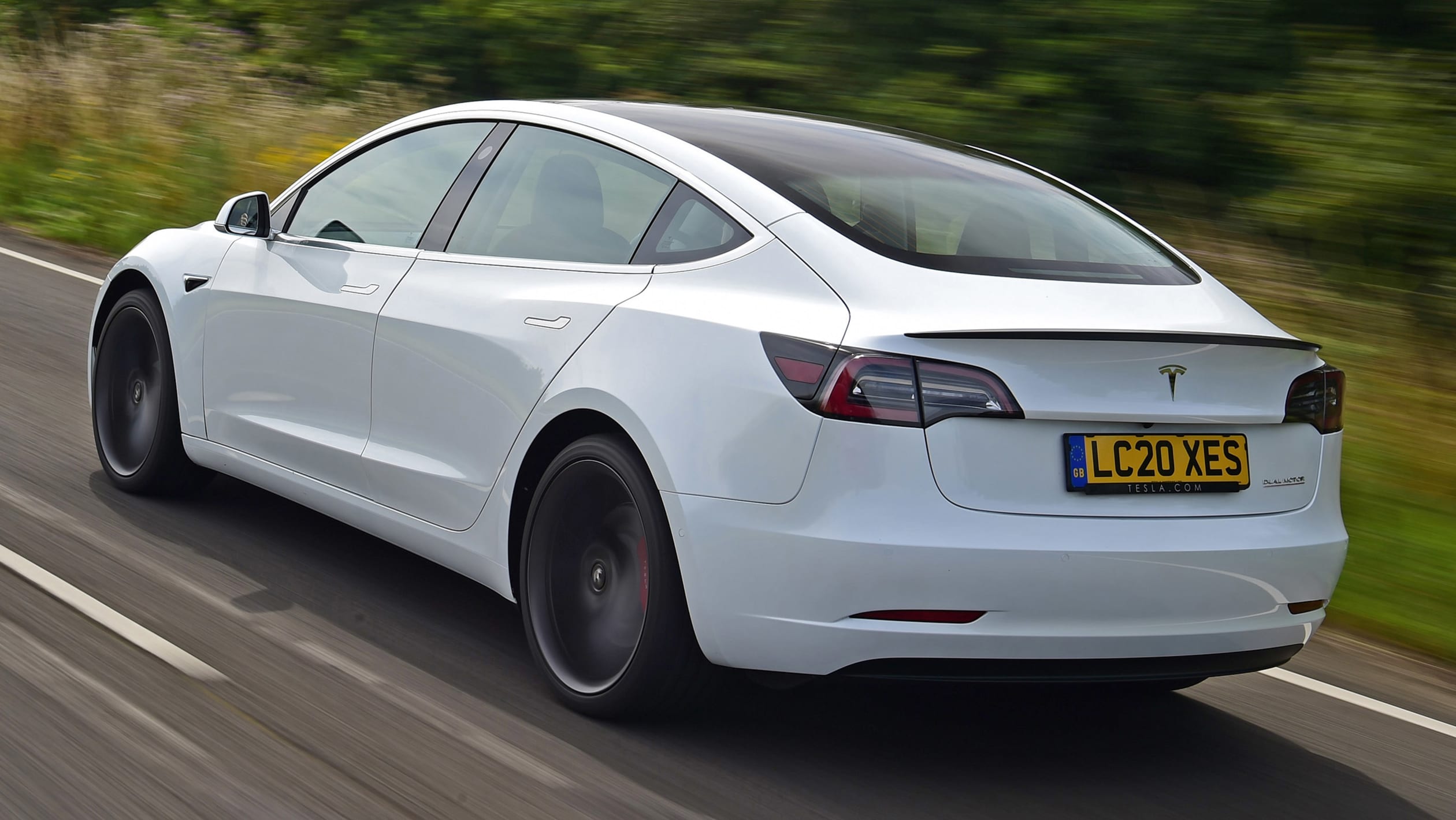
The softer suspension and extra power mean the Model 3 doesn’t feel quite as composed as the Polestar, however. The steering is quick and can unsettle the car if you’re too aggressive. No matter what mode it’s set to, it’s not as nice as the 2’s. Surprisingly, despite it being the lower, lighter car, it feels like the Tesla rolls more, but there’s still a good level of grip and great traction.
Practicality
Tesla claims a total cargo capacity of 542 litres, but this isn’t the whole story. Together, the front and rear areas offer 425 litres, and although the Model 3 is a sedan, the opening is relatively wide. There is a useful under-floor area, for extra bags or the charging cables. However, the ‘frunk’ is more than big enough to store these, so both offer more practicality than the figures suggest.
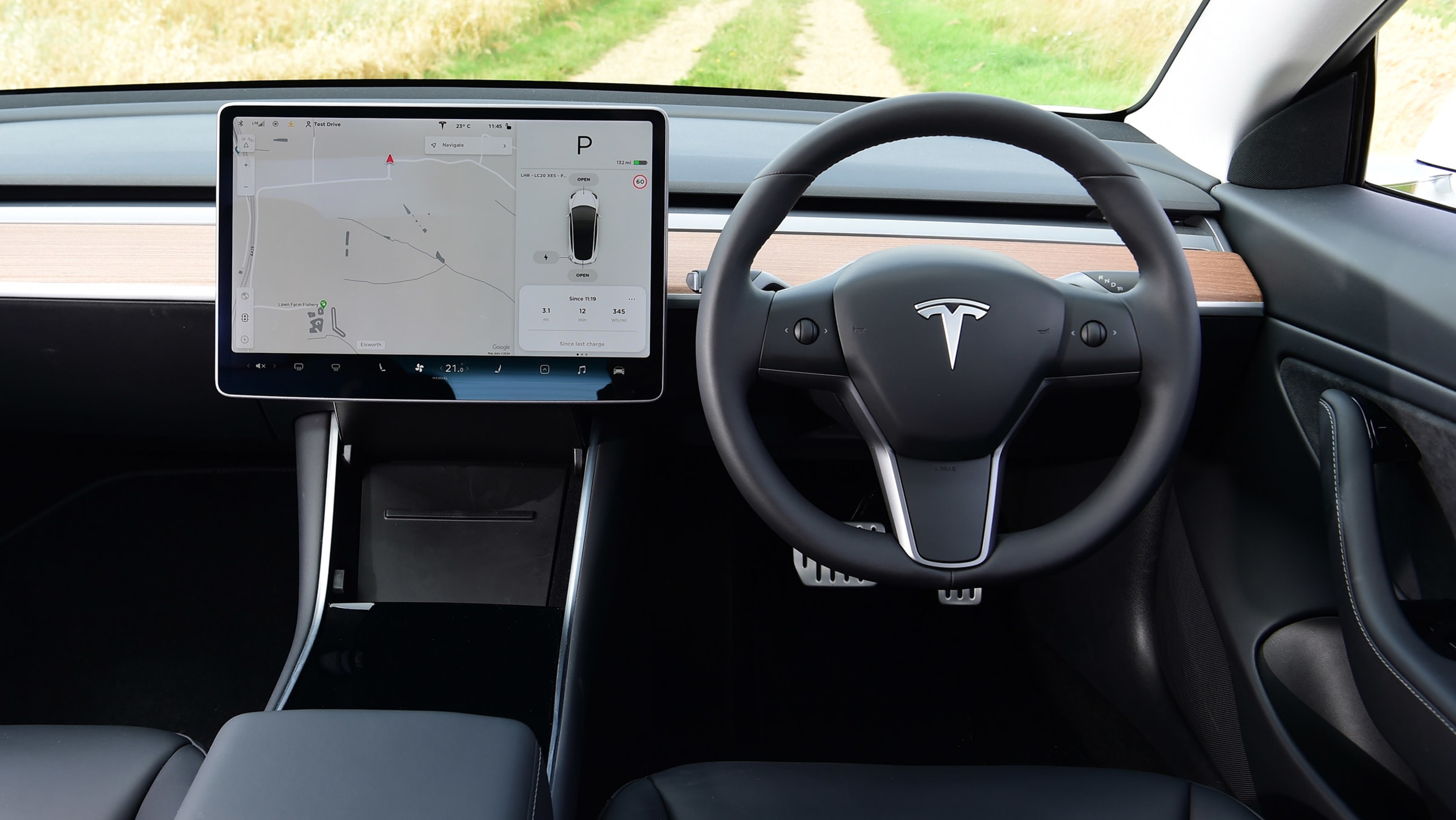
The Tesla is roomier in the rear. You sit lower and that curving roof means there’s more headroom. The panoramic roof is better executed, too, while legroom shades the Polestar. Storage in both is good, and although the materials around the Tesla’s main storage area aren’t the best, there is more space.
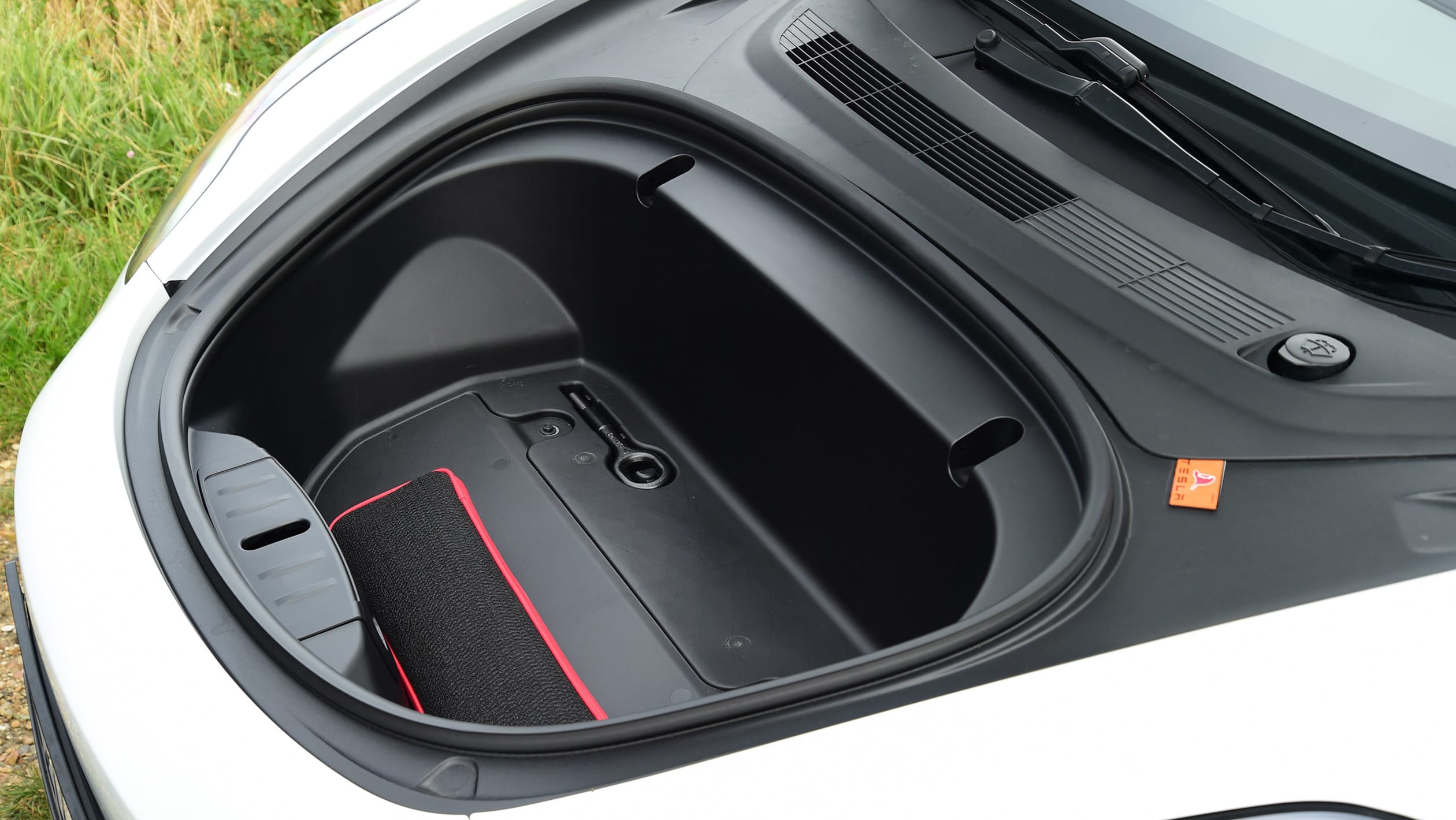
The Model 3 was the first Tesla to accept CCS charging, but with a 250kW V3 Supercharger an 80 per cent top-up takes around 15 minutes. Adding up to 121km of range in just five minutes makes longer journeys very easy.
Ownership
Satisfaction amongst Tesla owners is high, even though the brand didn’t rank in this year’s Driver Power poll.
There’s a level of autonomy that exceeds even the 2, with Tesla’s semi-autonomous cruise control standard, plus you can add full self-driving capability. This adds auto lane changing and auto parking with ‘Summon’, where you can park and retrieve your car without being in it. Otherwise, autonomous braking with lane-keep and blind-spot assist are all standard.
Running costs
Servicing should be cheaper on an electric vehicle due to fewer components than an ICE car – Tesla has moved to an ‘as needed’ service schedule, while Polestar – in Europe – offers three years’ maintenance free.
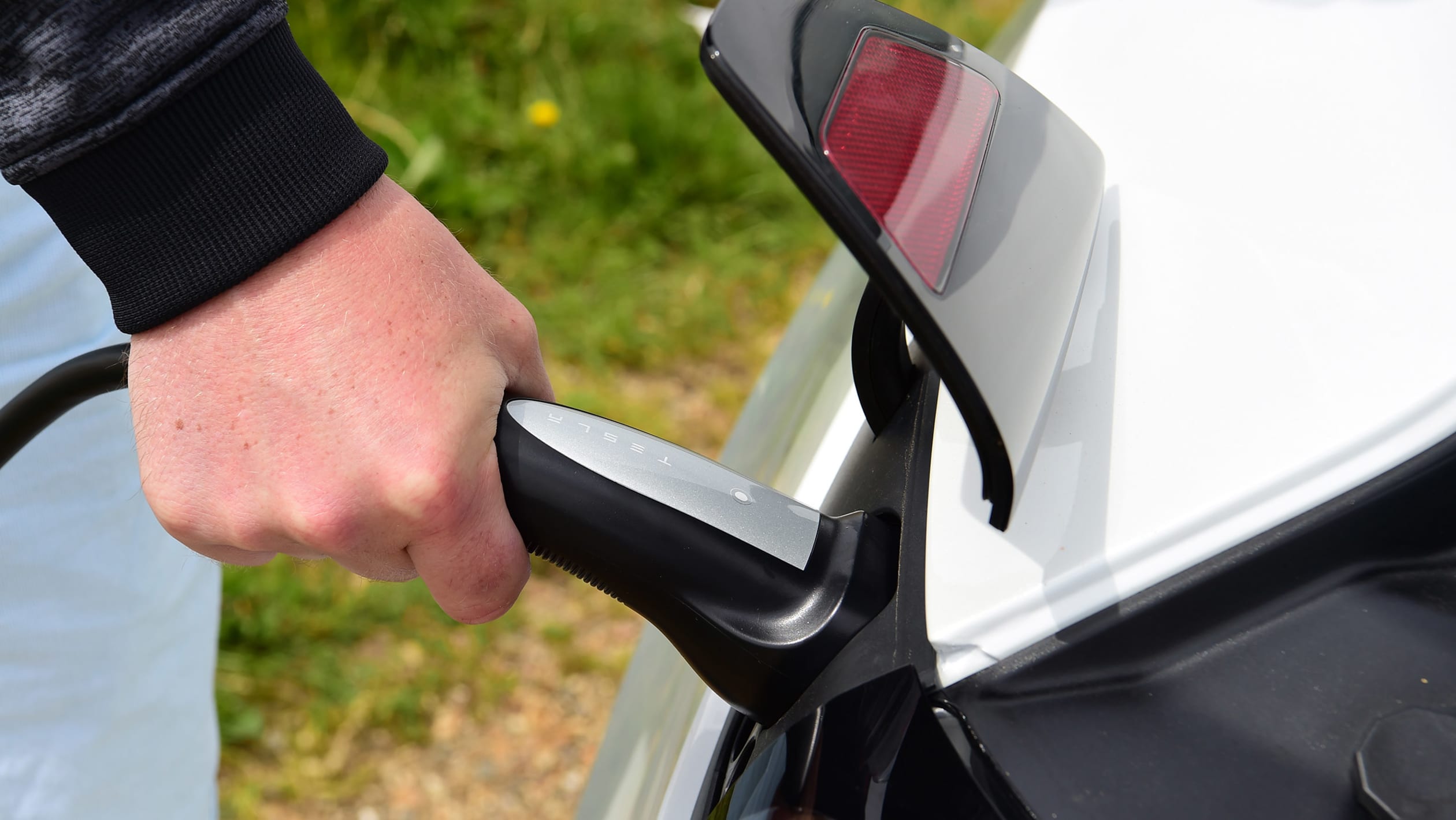
Testers’ notes: “Model 3’s charging port is located on left rear panel, the same as on the Polestar. Both feature two charging cables as standard that are long enough to offer flexibility when parking to charge the cars.”
Head-to-head: everything electric
Polestar 2
Both of these cars are sportier EVs that allow involving driving with just one pedal. The 2 has three levels of regenerative braking: off, low and high. In the strongest setting, the level of braking is similar to gently applying the brakes in a conventional car to the point that, with enough anticipation, you can drive through bends and down country roads without needing to touch the brake pedal or trouble those Brembo calipers.
It will even bring the car to a complete stop in town, so the Polestar offers proper one-pedal driving, just like the Tesla.
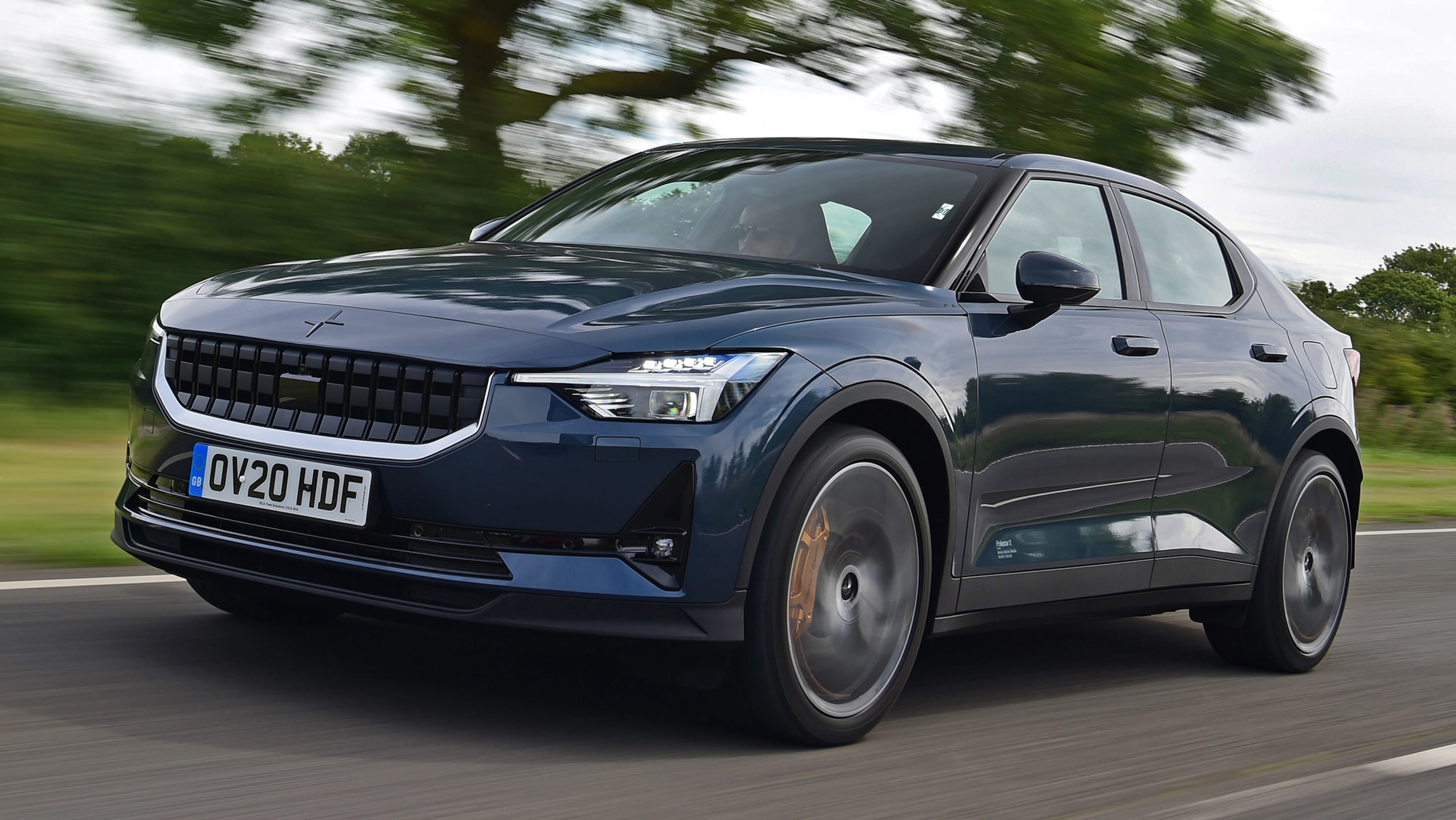
It’s nicely calibrated and offers more retardation at medium and lower speeds, so when you lift off at higher speeds on the motorway or a dual carriageway, the car coasts a little more and isn’t as aggressive in the way it slows down, helping comfort.
The three steering settings – light, standard and weightier – change the character of the car subtly as well. There’s no more feedback in any of the heavier modes, but the extra weight means it feels nicely planted and stable in quicker corners.
Using tech engineered for Volvo’s road cars, it’s clear Polestar and its siblings have the benefit of years of automotive engineering under their belts, because it’s one of the best-driving EVs we’ve tried yet.
Tesla Model 3
The way Polestar structures its different modes and settings is no surprise, because they’re very similar to the how Tesla does it, and this is the brand that set the template for performance EVs at this price.
There are two modes for the accelerator response: Chill and Standard. The former softens the throttle for a more progressive response, while the latter gives you more of the car’s huge performance more quickly in reaction to throttle movement; response is instant and feels even sharper than the Polestar, although that’s probably amplified by the extra power, too.
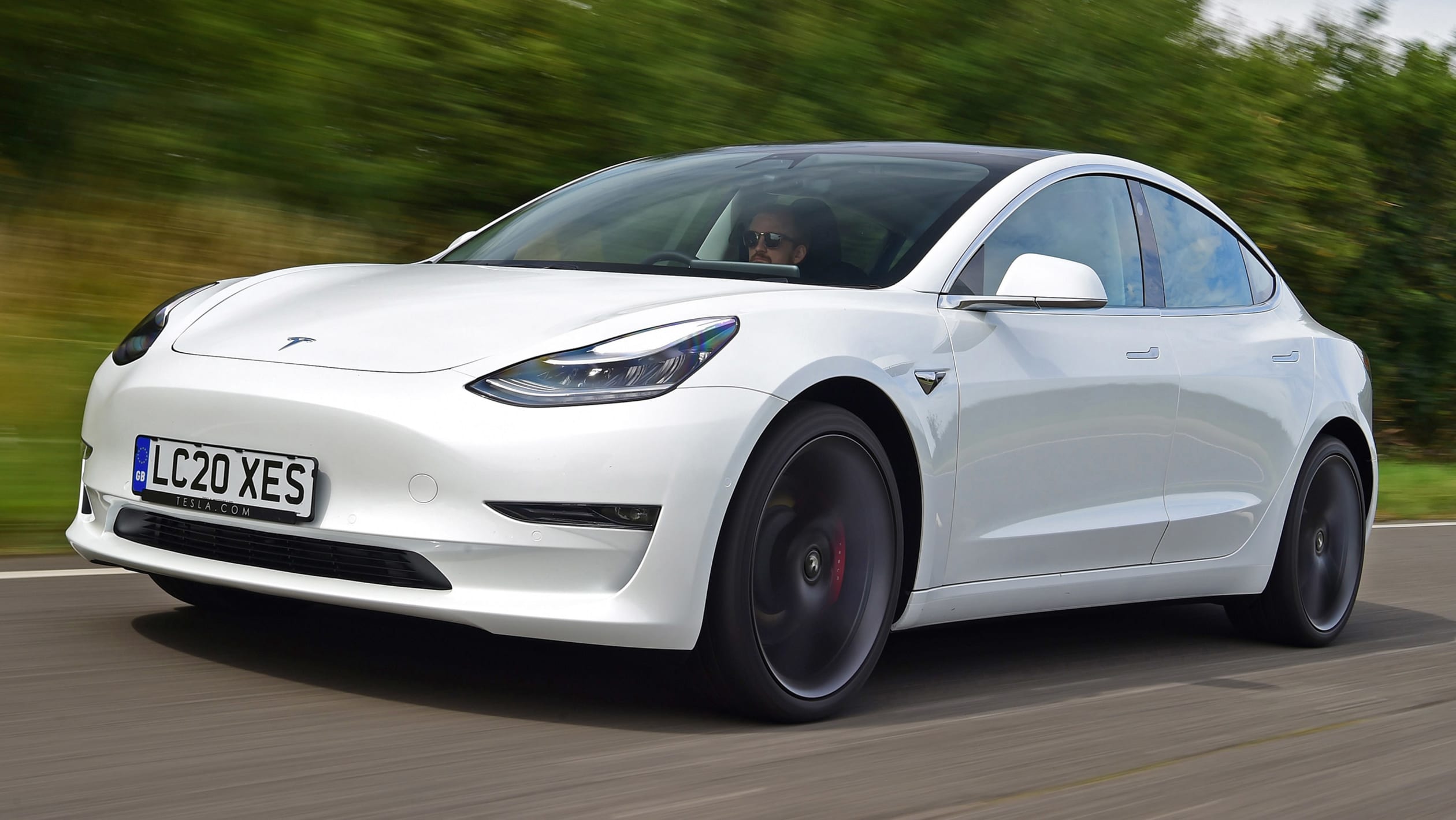
The Model 3 has three steering modes: Comfort, Standard and Sport. We think Comfort or Standard are the nicest. There’s even less information relayed to the driver through the wheel rim in the Tesla, while the Sport setting feels artificially heavy and too quick for the chassis.
This element means the Model 3 isn’t quite as engaging as the Polestar. But its brake regeneration is really nicely judged to the point where, in the stronger of the two settings on offer, you can string a series of corners together nicely.
It proves that EVs can be fun to drive, even if there isn’t as much interaction with the car as in a normal sports sedan. The stronger regeneration setting will bring the Tesla to a halt as well.
Verdict
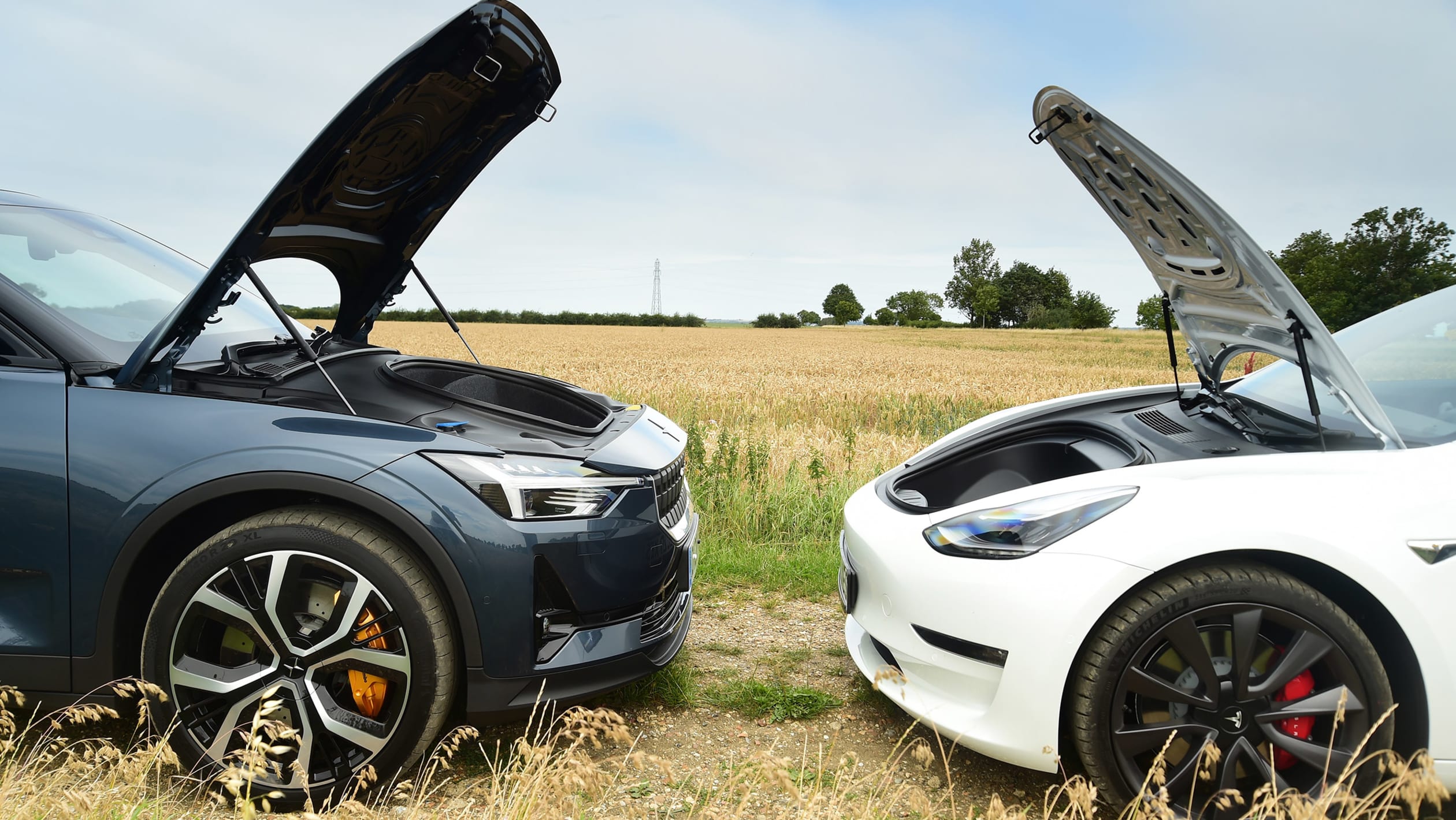
First place: Tesla Model 3
The Model 3 Performance is blisteringly quick, yet more efficient and cheaper to run than the already frugal Polestar. It offers more range and faster recharging potential, while the on-board tech is cutting-edge; the 2 mostly matches it, but the Tesla is softer and more comfy more of the time. It has a bit more practicality, which means this premium family EV just edges it.
Second place: Polestar 2
The 2 is a fine first EV from Polestar, which isn’t surprising given its relationship to Volvo. It handles sweetly despite its weight, even if there’s a trade-off in ride quality, but it can’t match the Tesla’s pace, efficiency or real-world range. The tech is just as good, and while it lacks a little of the Model 3’s space, the Polestar has quality, style and driving dynamics on its side. It’s a great EV alternative to Tesla.





